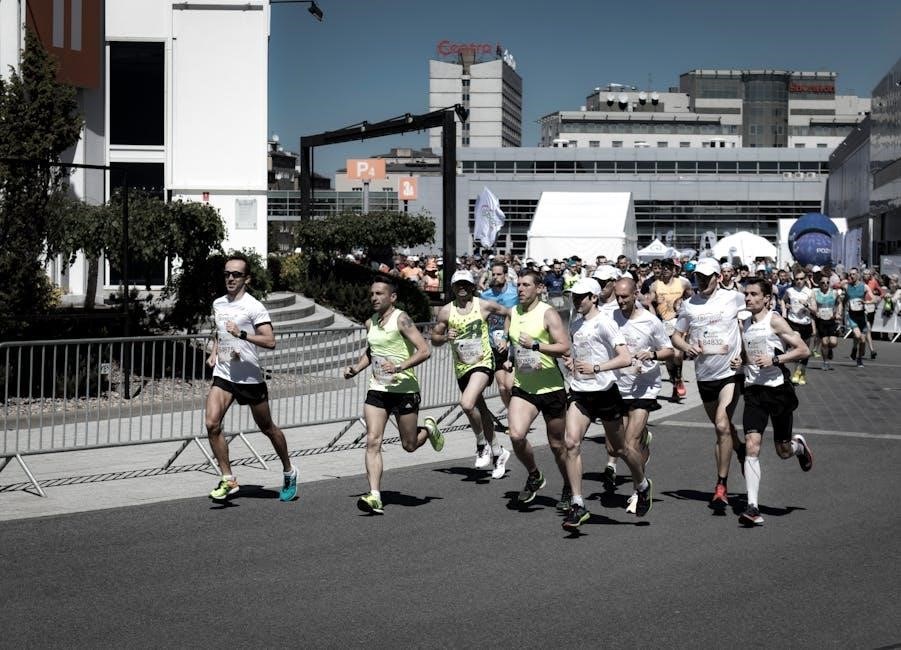A structured approach for first-time marathon runners‚ focusing on consistency‚ progressive overload‚ and building endurance. This plan combines speed workouts‚ long runs‚ and rest to ensure optimal preparation and mental resilience.
Overview of the Training Plan
This 16-week structured program is designed for first-time marathoners‚ focusing on gradual progression to build endurance and stamina. It starts with foundational mileage‚ incorporating speed workouts‚ long runs‚ and rest days. The plan emphasizes consistency‚ with weekly mileage increasing steadily to adapt to demands. Key components include cross-training and strength sessions to enhance running efficiency and prevent injuries. By balancing intensity and recovery‚ runners can safely progress toward their marathon goal. The plan is tailored for those with some running experience‚ ensuring a balanced approach to prepare both physically and mentally for race day.
Importance of Consistency and Progressive Overload
Consistency is the cornerstone of a successful marathon training plan‚ ensuring gradual adaptation to physical demands. Progressive overload involves systematically increasing mileage and intensity to build strength and endurance. Each week‚ small increments in training load prepare the body for longer distances‚ reducing injury risk. Without consistent effort‚ runners may struggle to achieve their marathon goal. Balancing intensity with recovery allows the body to adapt‚ fostering long-term progress. This approach helps beginners build resilience and confidence‚ essential for completing 26.2 miles. By adhering to a structured plan‚ runners can avoid plateaus and stay on track for race day success.

Key Components of a Beginner Marathon Plan
A well-rounded plan includes base building‚ speed workouts‚ and long runs‚ ensuring a gradual increase in endurance and strength‚ tailored to a first-time marathon runner’s needs.
Understanding the Importance of Base Building
Base building is the foundation of any successful marathon training plan. It involves gradually increasing weekly mileage to improve cardiovascular endurance‚ muscular strength‚ and mental stamina. This phase focuses on consistent‚ low-intensity runs that allow the body to adapt without risking injury. By building a strong aerobic base‚ runners enhance their ability to handle more intense workouts later in the training cycle. A well-structured base period ensures that runners develop the endurance needed to tackle longer distances‚ making it essential for beginners to patient through this initial phase. Proper base building sets the stage for a successful and injury-free marathon preparation journey.
Role of Speed Workouts in Marathon Training
Speed workouts are crucial for improving running efficiency and endurance in marathon training. They help runners develop a faster lactate threshold‚ allowing them to maintain a steady pace over long distances. Incorporating interval training‚ tempo runs‚ and fartleks enhances cardiovascular fitness and muscular endurance. These sessions also boost mental toughness‚ teaching runners to push through fatigue and maintain focus. While long runs build endurance‚ speed workouts refine running form and increase stride turnover. They prevent plateaus by adding variety to training‚ ensuring a well-rounded approach to marathon preparation. Balancing speed and endurance is key to achieving peak performance on race day‚ making speed workouts an essential component of any effective training plan.
Long Runs and Their Significance
Long runs are the cornerstone of marathon training‚ designed to build cardiovascular endurance‚ muscular strength‚ and mental resilience. These extended sessions simulate race conditions‚ helping runners adapt to the physical and psychological demands of covering 26.2 miles. By gradually increasing weekly long run distances‚ runners enhance their body’s ability to store glycogen and metabolize fat as fuel. This progressive overload reduces the risk of injury and improves overall performance. Additionally‚ long runs teach proper pacing‚ hydration‚ and nutrition strategies‚ which are critical for race success. They also foster mental toughness‚ allowing runners to overcome fatigue and maintain confidence during the final miles of the marathon.

Setting Realistic Goals for Your First Marathon
Define a realistic finish time based on current fitness and gradually progress to achieve it‚ balancing ambition with safety to ensure a successful and injury-free debut marathon experience.
Defining Your Marathon Finish Time Goal
Setting a realistic marathon finish time goal is crucial for beginners. Consider your current fitness level‚ running experience‚ and past performance in shorter races. Consider factors like training consistency‚ injury history‚ and overall health. Aiming for a time that is challenging yet achievable helps maintain motivation and reduces the risk of burnout or injury. For example‚ if you can complete a half-marathon in 2 hours‚ a realistic marathon goal might be 4:30 to 5 hours. Use pacing guidelines and training metrics to refine your target. Having a clear finish time goal helps structure training‚ build confidence‚ and ensures a positive first marathon experience.
Creating a Race-Specific Pace Plan
A race-specific pace plan is tailored to your marathon goal and course conditions. Start by determining your goal pace per mile‚ considering factors like elevation changes and weather. Incorporate strategies like even pacing‚ where you maintain a consistent speed throughout the race. Negative splitting‚ starting slightly slower and increasing pace‚ can also enhance performance. Use training data to simulate race conditions and practice fueling‚ hydration‚ and gear. Adjustments may be needed based on course topography—flatten efforts on hills‚ for example. A well-structured pace plan ensures you stay on track‚ avoid burnout‚ and maximize your potential for a successful marathon finish.

Weekly Training Structure
A balanced mix of running‚ rest‚ and cross-training‚ with weekly mileage progression‚ speed workouts‚ and long runs to build endurance and strength systematically.
Weekly Mileage and Progression
A beginner-friendly marathon plan typically starts with 10-15 miles per week‚ gradually increasing by 10% weekly to avoid injury. The structured progression ensures adaptation‚ with a mix of easy runs‚ speed workouts‚ and long runs. Peak mileage occurs around week 12-14‚ followed by a taper phase to allow recovery. Consistency is key‚ with rest days and cross-training incorporated to balance intensity. This approach builds endurance‚ stamina‚ and mental resilience‚ preparing runners for race day. The plan emphasizes gradual overload‚ ensuring runners adapt safely and confidently toward their first marathon goal.
Breakdown of Weekly Workouts
A typical week includes 3-4 runs‚ with one speed workout‚ one long run‚ and 1-2 easy runs. Speed workouts enhance endurance and pace‚ while long runs build stamina. Easy runs promote recovery and consistency. Rest days or cross-training (e.g.‚ cycling or swimming) are included to prevent injury and allow recovery. The plan balances intensity with recovery‚ ensuring gradual progression. Each workout type serves a specific purpose‚ aligning with the overall goal of marathon readiness. This structured approach helps beginners adapt safely and confidently‚ avoiding burnout while building the necessary endurance for race day.
Importance of Rest and Recovery Days
Rest and recovery days are crucial for allowing your body to repair and adapt after intense training. Without adequate recovery‚ you risk injury‚ fatigue‚ and decreased performance. Rest days enable muscle repair‚ replenish energy stores‚ and support mental rejuvenation. They also help maintain immune function and overall well-being. Incorporating rest into your training plan ensures long-term progress and prevents burnout. Active recovery‚ such as light walks or stretching‚ can be beneficial but should not replace complete rest. Listening to your body and honoring recovery days is essential for sustainable improvement and achieving your marathon goal. Consistency in recovery fosters resilience and readiness for race day.

Nutrition and Hydration for Marathon Training
Proper nutrition and hydration are essential for energy‚ recovery‚ and performance. A balanced diet and strategic fueling ensure optimal endurance and support overall training demands effectively.
Fueling for Long Runs and Workouts
Proper fueling is critical for endurance during long runs and intense workouts. Focus on consuming complex carbohydrates‚ lean proteins‚ and healthy fats to provide sustained energy. Hydrate with water or electrolyte-rich drinks to maintain fluid balance and prevent dehydration. Practice fueling strategies during training to determine what works best for your body‚ such as consuming a meal or snack 1-3 hours before a workout. Avoid heavy or new foods to prevent digestive discomfort. During long runs‚ consider carrying energy gels or snacks to replenish glycogen stores. Experiment with different timing and portions to optimize performance and recovery‚ ensuring you’re prepared for race day conditions.
Hydration Strategies for Optimal Performance
Proper hydration is essential for maintaining endurance and preventing dehydration during marathon training. Aim to drink 8-10 glasses of water daily‚ increasing intake during intense or long workouts. Practice hydrating before‚ during‚ and after runs to develop a routine. For runs lasting over an hour‚ consider carrying a hydration pack or using electrolyte-rich drinks to replenish lost salts. Monitor urine color to ensure it’s pale yellow‚ indicating adequate hydration. During races‚ plan your water intake based on the course’s water stations and your body’s needs. Experiment with different hydration strategies during training to avoid stomach discomfort and optimize performance on race day. Stay consistent to maintain peak physical condition.

Mental Preparation and Motivation
- Set realistic goals to track progress and stay motivated.
- Practice visualization to build confidence for race day.
- Develop a growth mindset to embrace challenges as opportunities.
- Stay positive by celebrating small victories during training;
- Keep a training journal to monitor progress and stay inspired.
Building Mental Toughness for Race Day
Mental toughness is crucial for marathon success‚ helping you push through challenges and maintain focus. Start by setting realistic goals and practicing visualization techniques to imagine race-day scenarios. Use positive affirmations to build confidence and stay motivated during tough workouts. Embrace discomfort during training runs‚ as this strengthens resilience. Incorporate mindfulness practices to stay present and manage race-day nerves. Break the marathon into smaller segments to maintain focus and celebrate progress. Surround yourself with supportive runners or mentors to stay inspired. Consistently remind yourself of your training efforts to reinforce self-belief. Over time‚ these strategies will help you develop the mental strength needed to conquer the 26.2 miles with confidence and determination.
Overcoming Common Challenges in Training
Common challenges in marathon training include injuries‚ mental fatigue‚ and time management. Prioritize rest and recovery to prevent overtraining‚ as this is key to avoiding injuries. Stay consistent with hydration and nutrition‚ especially during long runs‚ to maintain energy levels. Break training into manageable segments and celebrate small milestones to stay motivated. Incorporate cross-training or strength exercises to reduce the risk of repetitive stress injuries. Seek advice from experienced runners or coaches to address specific concerns. Stay flexible with your training plan and adjust as needed to accommodate life’s demands. Remember‚ perseverance and adaptability are vital for overcoming obstacles and reaching race day ready.

Choosing the Right Gear for Marathon Training

Invest in proper running shoes with good support‚ moisture-wicking apparel‚ and essential accessories like water bottles or belts. These elements ensure comfort and performance during training.
Selecting the Right Running Shoes
Choosing the right running shoes is crucial for comfort‚ performance‚ and injury prevention. Look for shoes with proper support‚ cushioning‚ and breathability. Visit a specialty running store for a gait analysis to determine your foot type and stride. Replace shoes every 300-500 miles or when showing signs of wear. Proper fit ensures reduced risk of injuries like shin splints or plantar fasciitis. Avoid overly worn-out shoes‚ as they lose support and cushioning. Investing in the right pair enhances your training experience and helps you stay consistent. A good pair of shoes is an essential foundation for any successful marathon training plan.
Importance of Proper Running Apparel
Proper running apparel is essential for comfort‚ performance‚ and safety during training. Choose moisture-wicking fabrics to keep you dry and breathable materials to regulate body temperature. Opt for clothes that fit well to avoid chafing and discomfort. Consider the weather—lightweight gear for heat‚ layers for cold‚ and waterproof items for rainy conditions. Supportive accessories like sports bras and compression wear can enhance performance and reduce injury risk. Reflective or bright clothing improves visibility during early morning or evening runs. Prioritizing proper apparel ensures a more enjoyable and effective training experience‚ helping you stay focused on your marathon goals.
Essential Accessories for Marathon Training
Essential accessories play a crucial role in enhancing comfort‚ performance‚ and safety during marathon training. A hydration belt or vest is vital for carrying water and electrolytes on long runs. A pacing band helps maintain consistent speed‚ while a heart rate monitor tracks effort levels. Sunglasses and a hat protect against sun glare and heat. Anti-chafing products like Vaseline or creams prevent discomfort and skin irritation. A running watch or fitness tracker monitors progress‚ distance‚ and recovery. Energy gels and chews are indispensable for fueling during extended workouts. Reflective gear or lights improve visibility in low-light conditions. These accessories ensure a more enjoyable and effective training experience‚ supporting overall performance and recovery.

Sample 16-Week Training Plan
A structured 16-week program designed for beginners‚ progressing from foundational fitness to race readiness. It includes base building‚ speed workouts‚ and taper phases to ensure peak performance.
Weeks 1-4: Building a Foundation
These initial weeks focus on establishing a consistent running routine. Incorporating short runs‚ walk breaks‚ and cross-training helps build endurance and prevents injury. Easy runs at a conversational pace promote recovery‚ while strength sessions enhance overall fitness. Gradually increasing weekly mileage ensures a solid base for more intense training later. Rest days are crucial during this phase to allow the body to adapt. This period lays the groundwork for future progress‚ making it essential to follow the plan diligently and listen to your body to avoid overtraining.
Weeks 5-8: Increasing Endurance
During these weeks‚ the focus shifts to enhancing stamina and mental toughness. Long runs are extended to build endurance‚ with intervals and tempo runs introduced to improve pacing. Incorporating speed workouts at a slightly faster pace than the goal marathon time helps boost cardiovascular fitness. Rest and recovery remain vital‚ ensuring the body adapts to the increased demands. Walk breaks during long runs are reduced‚ and cross-training continues to support overall fitness. This phase is critical for developing the resilience needed for the later stages of training‚ laying a strong foundation for the challenges ahead. Consistency and patience are key during this period.
Weeks 9-12: Introducing Speed and Strength
These weeks focus on building speed and strength to enhance running efficiency and endurance. Interval runs and tempo workouts are introduced to improve cardiovascular fitness and mental resilience. Strength training sessions‚ such as core exercises and lower-body workouts‚ are incorporated to prevent injuries and boost power. Long runs continue to increase in distance‚ with a focus on maintaining a consistent pace. Walk breaks are minimized‚ and runners are encouraged to practice fueling strategies during long runs. This phase prepares the body for the demands of race day‚ ensuring runners are both physically and mentally ready for the final push. Consistency and recovery remain key to progress.
Weeks 13-16: Taper and Race Preparation
These final weeks focus on reducing training volume to allow the body to recover and adapt. Weekly mileage is gradually decreased to prevent fatigue‚ while intensity remains controlled. Active recovery‚ such as easy runs and cross-training‚ is emphasized to maintain fitness without overexertion. Race-specific strategies are refined‚ including pacing‚ hydration‚ and nutrition plans. Mental preparation becomes a priority‚ with visualization techniques and positive affirmations to build confidence. Rest and sleep are prioritized to ensure peak performance on race day. The taper phase ensures runners feel fresh‚ strong‚ and mentally prepared to tackle the 26.2-mile journey with confidence and endurance. Proper gear checks and race-day logistics are finalized during this period.

Tips for Race Day
Arrive early‚ wear proper attire‚ and fuel with familiar nutrition. Stay hydrated‚ pace yourself‚ and draw energy from the crowd to maintain focus and endurance throughout the race.
Final Preparations for the Marathon
The last few days before the marathon are critical for ensuring you’re fully prepared. Taper your training to allow your body to rest and recover‚ avoiding strenuous workouts. Focus on proper nutrition by carb-loading 2-3 days prior‚ and stay hydrated by drinking plenty of water. Lay out your race-day gear‚ including your running shoes‚ comfortable clothing‚ and any necessary accessories like a pace band or hydration belt. Mentally prepare by reviewing the course‚ setting realistic expectations‚ and visualizing a successful finish. Avoid trying new foods or products to prevent any digestive issues. Get plenty of sleep and arrive early at the starting line to soak in the atmosphere and stay calm.
Navigating the Course and Staying Focused
Navigating the course and staying focused are crucial for a successful marathon experience. Study the route beforehand to identify key landmarks‚ aid stations‚ and challenging sections like hills or windy areas. Break the race into smaller segments‚ focusing on one mile at a time to maintain mental clarity. Use visual markers or pace bands to track your progress and stay on target. Fuel and hydrate according to your pre-planned strategy‚ ensuring you take advantage of aid stations without overloading. Stay present in the moment‚ drawing energy from spectators and fellow runners. Keep a positive mindset‚ especially during tough miles‚ and remind yourself of your training and preparation. Trust your abilities and push through to the finish line with determination and resilience.
Completing a marathon is a remarkable achievement‚ requiring dedication‚ perseverance‚ and mental strength. Embrace the journey‚ celebrate progress‚ and let your hard work fuel a triumphant finish.
Summarizing the Key Takeaways
A successful marathon journey begins with a structured training plan‚ emphasizing consistency‚ progressive overload‚ and recovery. Prioritize building a strong foundation through base miles‚ speed workouts‚ and long runs. Set realistic goals‚ fuel your body with proper nutrition‚ and stay hydrated. Mental toughness and gear preparation are equally vital. Listen to your body‚ embrace challenges‚ and celebrate small victories. With dedication and persistence‚ crossing the finish line becomes a testament to your hard work and resilience. Remember‚ marathon training is not just about the race—it’s about the transformative journey that shapes both body and mind.
Motivation for Future Marathon Training
Completing your first marathon is a life-changing achievement‚ fueling a lifelong passion for running. Each training cycle offers opportunities to set new goals‚ explore races‚ and push personal limits. Embrace the journey‚ celebrate progress‚ and stay inspired by the running community. Remember‚ every mile is a step toward growth and self-discovery. Whether aiming for faster times or new distances‚ the lessons learned in your first marathon will serve as a foundation for future success. Let the joy of running motivate you to continue challenging yourself and pursuing new horizons in endurance and personal development.
